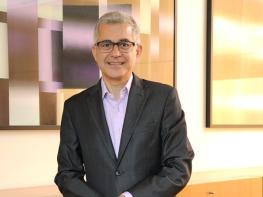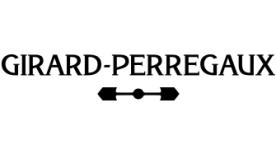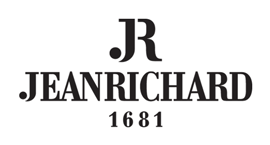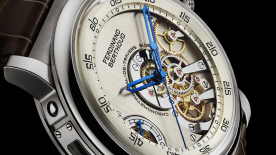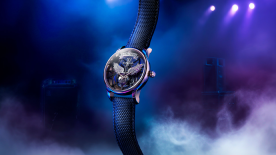At what stage is the reorganization announced by the Kering Group last summer?
Firstly I would like to correct a point because we haven’t undertaken any kind of reorganization in the true sense of the term – that is not part of the mindset of what we have undertaken. The Executive Committee simply wanted to clarify the hierarchical structures for all the entities by imposing a simple principle: that each entity can enjoy the benefit of its own full-time CEO.
This means Sowind and Ulysse Nardin on the one hand and the whole of Gucci Watches and Jewelry on the other and which is not my responsibility. In addition we are in the process of closing with a candidate who will join us, once he has been relieved of his current position, in order to Sowind, which regroups Girard-Perregaux and Jeanrichard. Bruno Grande remains the CEO for Jeanrichard and his expertise is invaluable to us..
What are your priorities in the mid-term?
Nothing extreme. This being said, however, we are facing a somewhat unexpected degree of instability. For a very long time, everyone thought that we had a market that had finally stabilized, based on an American market that was in a growth mode, a stable European area, and an Asian market share which continued to grow, despite being slightly more restrained than during the period of Chinese over-consumption with its well-known characteristics. But in my humble opinion, two very distinct elements have had game-changing effects: firstly, Chinese growth is definitively no longer at the level to which we had become accustomed; and very probably the consumption of over-stock that has been accumulated over the past few years has not been absorbed.
This change in economic climate will calm things down, as is reflected by Swiss export figures. Then there is a real decrease in the growth of the Russian clientele, both in Russia and everywhere where tourist shopping strongly benefited from their enthusiasm. Starting with Europe, but also to a lesser extent in the United States. The entire industry has had to revise its plans. We are fortunately not in a position of being forced to take the kind of drastic measures recently announced by other watchmakers, because our brands are characterized by their relatively modest scale, and historically, have maintained structures in line with their output.
“The industry is facing experiencing a somewhat unexpected state of volatility”
Albert Bensoussan
But a prudent approach prevails. Slight adjustments will undoubtedly need to be made. We will doubtless look at whether it is appropriate to continue spending at the same rate – for example in travel and communication – but I will not touch the investments in development that are proving fundamental, because our brands live pm the creations and innovations that they launch.
Could this climate be conducive to acquisitions and do you envisage adding to your brand portfolio at the top or bottom end?
That is a complex question that I will deal with as follows: collecting brands is not part of Kering’s vocation, no matter what the sector of activity. As regards watchmaking, we are the smallest group – that is a fact – and our environment was brutally consolidated 15 years ago. If one considers our high-end watchmaking universe, it has been more than 70% consolidated with LVMH, Patek Philippe, Richemont and Swatch Group. Therefore, if there were targets, and there aren’t, there would be very few and probably involving acquisition deals with steep valuation multiples, Consequently, our expansion objectives remain an organic priority. Now, if a veritable opportunity appeared, with well-established positioning, usual profitability and an international focus, it would not be realistic on our part to ignore it – be it a lifestyle or ultra-niche brand. Last summer we demonstrated with Ulysse Nardin that we were capable of seizing a great opportunity, and I should mention in passing that the price level at which the deal was made bears no relation to that which was reported in media. Today, there is nothing on the market that deserves our attention but we are keeping an eye out.
What is your view of the Grand Prix d’Horlogerie de Genève?
Generally speaking, I think that professional events such as the watchmaking fairs, for example, with their logic of gathering industry players together, deserve to be attended as long as they meet the expected quality criteria. As regards the Grand Prix d’Horlogerie de Genève, I hold it in high regard and not only because Girard-Perregaux won the “Aiguille d’Or” in 2013.
I like the fact that everyone can apply to demonstrate its skill in one category or another, I like the presence of a jury consisting of professionals parallel to an intervention by the public. I like the presentation that touches on serious subjects without taking itself too seriously. The ceremony is professional but approached with empathy for the brand being presented. It’s one of the very rare occasions on which one can express oneself socially and without too much at stake nor cutthroat competition like when the brands are in the markets. The GPHG is an opportunity to draw attention to new releases and innovations, which is healthy for the market and the positioning of the brands.
The forecast competition started by WorldTempus also reflects these aspects in a fun way. Not everyone can win every year, which is good and it provides a change. We discover brands that have not yet achieved substantial recognition and whose tenacity with regard to development over the past few years deserves recognition. In addition, the well-established brands with far greater resources can impose exceptional creations while continuing to defend the interests of the Swiss watchmaking industry.
